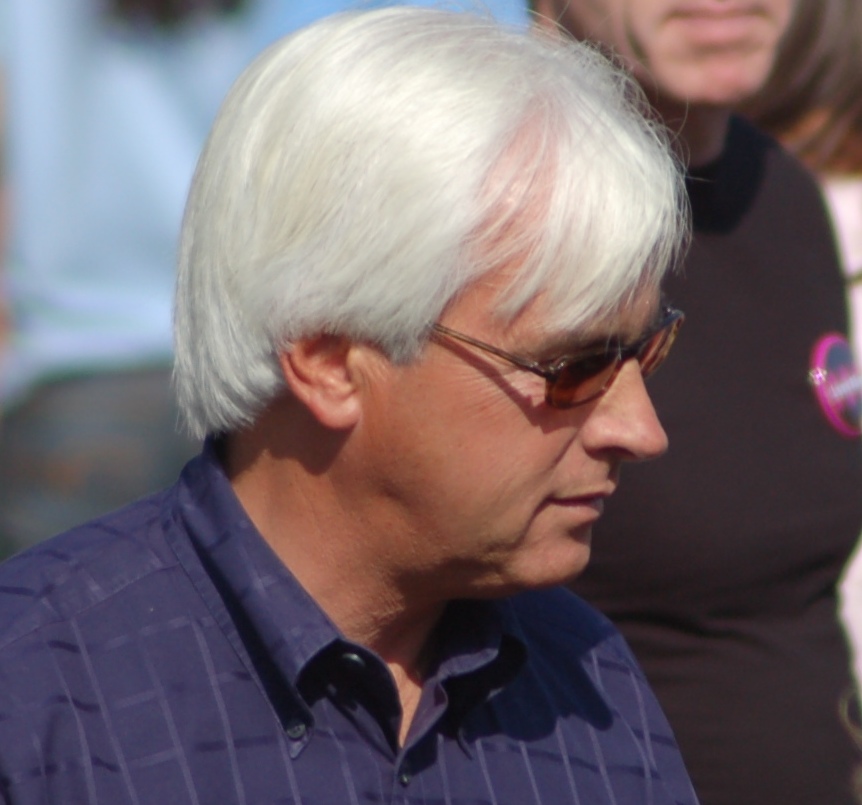So here came the new shooter from California, a dude with a mop of prematurely white hair, tinted sunglasses, and a rapier wit rarely seen on the backstretch of any American race track. The hardboots, as lifelong Kentucky horsemen are known, weren’t sure what to make of Bob Baffert except that he sure didn’t seem to take the Kentucky Derby as seriously as he should.
The year was 1996, hard to believe, and Baffert was at Churchill Downs with Cavonnier, the winner of the Santa Anita Derby. At first glance, the hardboots noted several similarities with D. Wayne Lukas, then at the height of his career. Like Lukas, Baffert was a former quarter-horse trainer. Like Lukas, he was partial to starched jeans. And like Lukas, he was a journalist’s dream, filling up notepads and tape recorders by the score.
The Derby media couldn’t get enough of him that spring, and one reason was that many, like the hardboots, figured they would never see him on the Derby backstretch again. He was just too glib, too funny, too California cool to go the distance. Heck, the rumors went, the guy was so laid back that he sometimes didn’t even show up at his barn until 8 a.m., outrageously late for a trainer who wants to be taken seriously.

But everybody began looking at Baffert a little differently when Cavonnier ran second in the Derby, beaten by Grindstone in what was as close to a dead heat as it’s possible to get. Unfortunately for Baffert, Cavonnier ran a dull fourth as the Preakness favorite and then pulled up lame in the Belmont Stakes. So much for Baffert, the one-hit wonder, right?
Well, not exactly.
Sunday morning, Baffert ruled the backstretch at Churchill like the Derby icon he is. He gave a TV interview, signed a few books and photos for ladies claiming to represent charities, and posed for photos. He looked pretty much the same as he did in 1996, but now he owns the stature that belongs only to Sunny Jim Fitzsimmons, Plain Ben Jones, Woody Stephens, Lukas, and the other legends of Derby history.
Already a Hall of Fame trainer, Baffert last year reached the pinnacle with American Pharoah, who became the sport’s first Triple Crown winner (Derby, Preakness, and Belmont) since Affirmed in 1978. The horse was almost a reflection of his trainer, so laid back that he would stand calmly while children young and old would pet him. He gave this generation an equine hero that measured up well against the best horses of the 20th century.
To Baffert’s eternal credit, he shared American Pharoah with the American public. Pharoah has surely been petted and photographed far more than any of the previous 11 Triple Crown winners. It was almost as if Baffert felt some kind of personal obligation to give back to all the people, big and small, who love horses and support the sport.
From a career standpoint, American Pharoah was the icing on Baffert’s cake.
He won the Derby back-to-back with Silver Charm and Real Quiet in 1997 and ’98. He again won the roses with War Emblem in 2003. All three of those colts were eligible to win the Triple Crown when they got to Long Island’s Belmont Park, the mile-and-a-half home of the Belmont Stakes.
All three had the Triple Crown cruelly snatched away. In ’97, Silver Charm looked like a winner until Touch Gold overcame him in the final stride. A year later, Real Quite seemed a bigger cinch in the stretch, only to get beat at the wire by Victory Gallop’s desperate charge. And in 2003, War Emblem stumbled badly at the start that he was out of it before he got the chance to run.
Another Triple Crown got away from Baffert in 2001 when Point Given got involved in a bumping incident at the start and didn’t fire in the stretch. He went on to win the Preakness, Belmont, Haskell and Travers to become the first horse ever to win four consecutive $1 million races. He was a shoo-in for the Eclipse Award for Horse of the Year.
A couple of milestones in Baffert’s evolution from wiseguy to wizard were his 2002 marriage to the former Jill Moss, who was working as a WAVE3 newscaster in Louisville when the trainer met her, and the serious heart attack he suffered in Dubai in March, 2010. The latter caused Baffert to change his diet, and, he says, become a different person emotionally. If he didn’t take the time to smell the roses after his first three Derby victories, he certainly did after American Pharoah’s triumph last year.
Baffert and Lukas are the best things that ever happened to the media assigned to cover the Derby and other thoroughbred events. Both are articulate, educated, opinionated, and immanently quotable. They manage to discuss a complicated business in terms that journalists and the public can understand. Even though he doesn’t have a Derby horse this year, you can bet that Lukas will give more interviews than some trainers who are in the race.
So far the year after Pharoah has been bittersweet for Baffert. The colt that seemed to be Baffert’s best Derby hope, Cupid, was injured in the Arkansas Derby and declared out of the big race at Churchill Downs. But Baffert still be represented by Mor Spirit, an intriguing colt owned by Michael Lund Petersen and ridden by three-time Derby winner Gary Stevens.
A son of Eskendereye, out of the Dixie Union mare Im a Dixie Girl, the dark brown colt has been favored in all seven of his career starts and never finished worse than second. In his last Derby prep, he went off as the $1.40 to $1 favorite in the Santa Anita Derby but could do no better than second, beaten more than six lengths by Exaggerator.
Memo to the public: This is a horse that can be bet, especially in exactas and trifectas. Never, ever underestimate a Baffert-trained horse in the Derby.
Naturally, the attention swirling around Mor Spirit isn’t nearly as intense as what Baffert faced last year with American Pharoah, and that seems just fine with the 62-year-old trainer. He loves to win, but he is far from greedy. He knows how blessed he was last year, and, in a way, is still trying to get accustomed to a horse and an achievement that put him in the highest echelon of America’s most talented and successful trainers.
The Kentucky hardboots still may not understand Baffert and his ways, but it makes no difference. The white-haired one has done it his way, and his way is better than almost anyone who gave a leg up to a jockey. He has a keen eye for a horse, a top-flight team around him, and a way of getting the most out of well-bred horses that routinely come his way from well-heeled owners.
On Sunday, Baffert had a kind word for the ladies who wanted his autograph for charity. He inspected a photo of himself sitting upon a gray pony and tried to remember the horse’s name. He humbly accepted congratulations for everything he’s done for racing since 1996.
And then Baffert had to hustle back to his barn to ready a few horses for workouts. The thing about the racing game, even for an icon, is that it’s much easier to slip from the top than it is to get there. American Pharoah is gone, but Mor Spirit – and more roses – beckon the man whose attitude about the Derby has changed from lively curiosity to a special kind of reverence.
Billy Reed is a member of the U.S. Basketball Writers Hall of Fame, the Kentucky Journalism Hall of Fame, the Kentucky Athletic Hall of Fame and the Transylvania University Hall of Fame. He has been named Kentucky Sports Writer of the Year eight times and has won the Eclipse Award twice. Reed has written about a multitude of sports events for over four decades, but he is perhaps one of media’s most knowledgeable writers on the Kentucky Derby






















